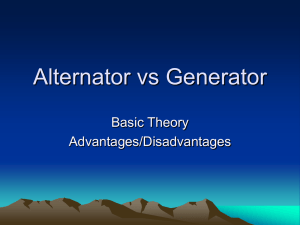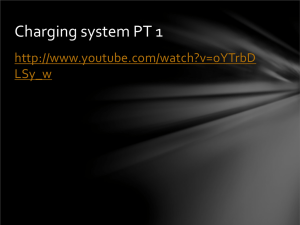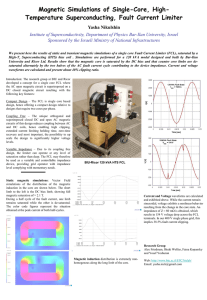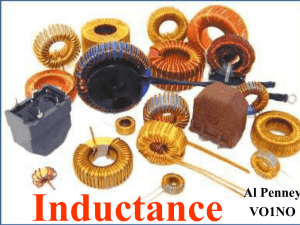HV Board project
advertisement
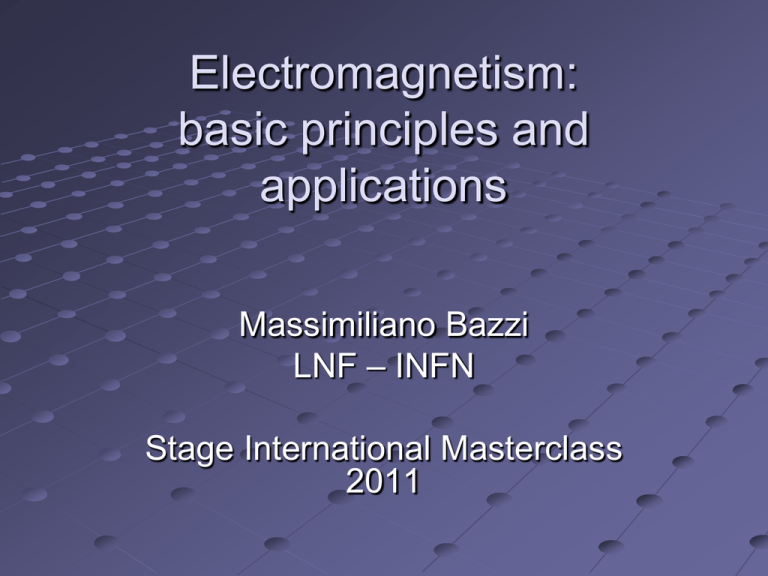
Electromagnetism: basic principles and applications Massimiliano Bazzi LNF – INFN Stage International Masterclass 2011 What is electromagnetism? Electromagnetism is the force that causes the interaction between electrically charged particles. It is as well one of the four fundamental interactions of nature. The other three are the strong interaction weak interaction gravitation Among the four electromagnetism is the most present in daily life and the most well known. Electric charge “Electric charge is a physical property of matter which causes it to experience a force when near other electrically charged matter.” Beyond plain definition, electric charge depends on electrons, which are the fundamental bricks of electromagnetism. The electron is a subatomic particle carrying a negative electric charge whose value is −1.602176487×10−19 Coulomb. Electrons form the outermost shell of the atom. They balance the positive charge of protons inside the nucleus, so matter tends to be electrically neutral. Some materials tend to acquire or to loose electrons breaking the electric balance (ie: rubbing bakelite or glass with wool). Electric charge bakelite glass bakelite bakelite By rubbing bakelite sticks with cloth, you can produce either attractive or repulsive phenomena Electric field The region of space in which an electromagnetic force is present is called electric field. It is generally represented by means of force lines. Electric Field • Electric field is by definition the force a particular source may apply on a fictitious charge of 1Coulomb. • Electric field intensity depends on the distance from the source and on the dielectric medium. Dimensionally it is expressed in Volt/meter (V/m). Electric potential • Like the gravitational field, we can introduce the concept of electric potential defined as the level of potential energy detected by a unitary charge immersed in an electric field in a certain position. • The electric potential is mathematically defined by the following • Single point potential is meaningless, but if we consider potential differences it becomes extremely useful. • Potential difference is known as voltage. Voltage A B E • Given two arbitrary locations A and B in an electric field, the voltage represents the work necessary to bring a unitary charge from A to B. • WAB = VB – VA Voltages and potentials are measured in Volt (V). Electric current • When charges flow from one position to another this phenomenon is called electric current • The current verse is always from positive to negative (when positive is the higher potential point) • Current unit is Ampère (A), and corresponds to a charge of 1C through the conductor section in 1s. Magnetic field • An electric current produces a magnetic field according to the right hand rule • Magnetic field is a force field whose force lines are closed • Its unit of measurement is ampère/meter (A/m) Voltage Source A voltage source is an element that maintains an electrical potential difference between its terminals and, therefore produces an electromotive force (e.m.f.) • The first voltage source ever realized was the Voltaic Pile in 1800 The voltaic pile transforms chemical potential in voltage • Before that the only way to dispose of electrical energy was the Leyden jar Electrical Resistance The electrical resistance of an electrical element measures its opposition to the passage of an electric current. • The resistance of an object can be defined as the ratio of voltage to current. This ratio is called Ohm's law. • V=R∙I Electrical Resistance • This effect can be explained by the presence of “obstacles” inside the conductor. • During their passage electrons collide with conductor molecules loosing their kinetic energy. • This energy loss is measured as a voltage drop at conductor extremities. • Electric energy loss becomes thermal energy (Joule's first law) Capacitance Capacitance is the ability of a body to hold an electrical charge. Capacitance is also a measure of the amount of electrical energy stored for a given electric potential. C=Q/V A common form of energy storage device is a parallel-plate capacitor whose capacitance is directly proportional to the surface area of the conductor plates and inversely proportional to the separation distance between the plates. Capacitance Inductance Inductance is the property of an electrical circuit causing voltage to be generated proportional to the rate of change in current in a circuit. It is a consequence of magnetic field generated by current. The inductor is a magnetic energy storage device The solenoidal shape increases inductance Inductor • The inductor stores magnetic energy by means of its shape It is the basic element of electromagnets, motors and transformers. By means of a magnetic core we can intensify magnetic flux Capacitance & Inductance Capacitance and inductance are frequently called reactances, since they react to an energy variation. The capacitor reacts to voltage variations (so to electric field). In static condition it works as an open circuit. The inductor react to current variations (so to magnetic field). In static condition it works as short circuit. The equation describing both devices contains derivatives! Direct current • Direct current (DC) is the unidirectional flow of electric charge constant in time. • It is typically generated from electric sources as batteries, thermocouples, solar cells. • Conventionally it flows from positive pole to negative • It is used to give energy to small devices Alternating current In alternating current (AC) the movement of electric charge periodically reverses direction. The usual waveform of an AC power circuit is a sine wave. Alternator • Alternator produces alternating current • By rotating a conductor winding embedded in a magnetic field you produce an e.m.f. • This principle is known as Faraday's law Alternator • magnetic flux is maximum when the winding plane is perpendicular to the field and null when parallel • By rotating the winding at a frequency F you produce a voltage sine wave at the same frequency • This is the most efficient way to transform mechanical energy into electric energy Alternator Alternators may have more independent windings and produce more waves • Each sine wave is called phase The angle between windings corresponds to the delay between phases AC / DC AC may be rectified, that is to say converted in DC!!! Transformer A transformer is a static device that transfers electrical energy from one circuit to another through inductively coupled conductors. A varying current in the first or primary winding creates a varying magnetic flux in the transformer's core and thus a varying magnetic field through the secondary winding. Ideal Transformer Real Transformer The physical limitations of the practical transformer may be brought together as an equivalent circuit model built around an ideal lossless transformer Electric Motor stator rotor We can transform electric energy back to mechanical energy. The motor in principle is similar to an alternator. Instead of a magnet and a winding, often we use two windings, rotor and stator. Magnetizing current is the same for both windings. Electric Motor brushes rotor stator switch Three-phase motor In the Three-phase motors there are three windings 120° distant inside the stator. By applying a three-phase current we obtain a rotating magnetic field. Maxwell's equations All electromagnetism is described by Maxwell's equations !!!! Electromagnetic wave equation By combining the previous equations we can obtain a new way to describe electromagnetism Through waves! • C0 is the speed of light!!! Electromagnetic waves Electromagnetic waves can be generated by a variety of methods, such as a discharging spark or by an oscillating molecular dipole. Electromagnetic spectrum Electromagnetism Pioneers André-Marie Ampère 1775 – 1836 Alessandro Volta 1745 – 1827 Electromagnetism Pioneers Michael Faraday 1791 – 1867 James Clerk Maxwell 1831 – 1879

